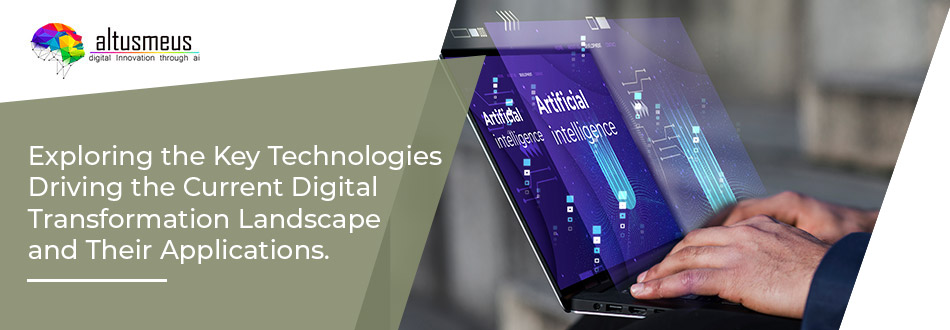In today’s rapidly evolving landscape, technology is advancing at an unprecedented pace. This rapid transformation has a profound impact on existing digital tools and technologies, rendering some of them outdated. The continuous emergence of new technologies is reshaping the digital realm and driving a transformative shift.
In this blog, we will explore the pivotal technologies driving the ongoing wave of digital transformation. These technologies are not only revolutionizing the way businesses operate but also transforming how they deliver products and services, interact with customers, and assist in cost-savings, process enhancement, and business growth.
Several key technologies are driving the digital transformation landscape, including AI, ML, IoT, edge computing, quantum computing, blockchain, and XR. We will discuss each of these technologies in more detail below.
Key Technologies Driving Digital Transformation
1. Artificial intelligence (AI)
ChatGPT’s groundbreaking introduction captivated the world, sparking a global conversation about AI. This paradigm shift triggered reactions across industries, awakening a realization that the future hinges on enhancing customer efficiency by integrating AI into their products. AI demonstrates its remarkable versatility, poised for significant growth in the years ahead, and it is also set to influence the utilization of other technologies.AI finds applications across various industries. Examples include AI-powered chatbots for 24/7 customer support, AI algorithms providing personalized product and service recommendations, streamlining complex processes, addressing business challenges, and automating specific tasks. Additionally, AI-driven fraud detection systems protect businesses from financial losses, showcasing the extensive range of AI applications.
2. Machine learning (ML)
When discussing AI, it’s important to note that it encompasses Machine Learning (ML), a crucial subset of AI. ML enables computers to autonomously acquire new knowledge without repetitive programming, making it a vital component of AI. Similar to AI, ML finds diverse applications across various industries.
ML finds applications across various industries. For example, it’s used in predictive analytics to forecast when a machine might fail or cease functioning. ML also contributes to tasks like crop yield prediction, disease detection, and precision farming, among many other applications.
3. Internet of Things (IoT)
The Internet of Things (IoT) consists of a vast array of physical devices interconnected via the internet. This extensive network generates a wealth of data, serving as a valuable resource for enhancing operational efficiency, streamlining processes, and fostering innovation in product and service development. In essence, the IoT transforms ordinary devices into data-driven tools, powering a new era of connectivity and opportunity.
IoT applications find utility in various industries where data serves as a cornerstone for decision-making. Since data generation is a common practice across all sectors, IoT can be effectively employed in nearly every industry. In the manufacturing sector, for example, sensors can be attached to packages to monitor the movement of goods along the supply chain, providing indispensable data to optimize logistical operations. Moreover, IoT streamlines rapid data transfer between devices. As an illustration, if a particular storage area’s raw material inventory is depleting, an IoT sensor can promptly convey this information to another sensor, which subsequently relays it to an executive. This allows for swift action, ensuring the timely replenishment of raw materials to prevent any inventory shortages.
4. Edge computing
Edge computing is a decentralized computing paradigm strategically locating computational resources closer to the network’s edge, where data originates. This approach reduces latency, bolsters security, and enables the development of new applications requiring immediate data processing. Essentially, edge computing optimizes data management and accelerates real-time decision-making by moving processing closer to the data’s source.
Think of edge computing as a technology that processes data from IoT devices right as it’s generated. This super-fast data processing leads to exciting possibilities like systems that can predict when your car or equipment might break down, and even self-driving cars that rely on this quick decision-making to navigate the roads safely.
5. Quantum computing
Quantum computing is an emerging field that leverages the principles of quantum mechanics for advanced calculations. Unlike classical computers, quantum computers hold the power to tackle previously insurmountable challenges, such as revolutionizing drug discovery and materials design with their unmatched problem-solving capabilities.
For example, quantum computers could potentially revolutionize the field of pharmaceuticals and materials science, paving the way for the development of groundbreaking drugs and cutting-edge materials that offer improved effectiveness and cost-efficiency compared to existing solutions.
6. Blockchain
Thanks to Bitcoin, blockchain technology has gained significant visibility. For those less familiar with blockchain, it’s a decentralized ledger technology used to securely record transactions and monitor assets, offering heightened security and transparency. The potential for blockchain to usher in a transformative era extends to various sectors, encompassing finance, supply chain management, healthcare, and more.
Blockchain technology finds its applications in various industries where transactions between parties occur. For instance, it can be harnessed to establish secure and transparent supply chains, aiding businesses in fraud reduction and efficiency improvement. Additionally, blockchain can facilitate the development of novel financial products and services, including cryptocurrencies and decentralized finance (DeFi).
7. Extended reality (XR)
XR, or Extended Reality, serves as an umbrella term encompassing virtual reality (VR), augmented reality (AR), and mixed reality (MR). These transformative XR technologies are leveraged to craft immersive experiences with applications ranging from training and education to entertainment, offering users a blend of the physical and digital worlds.
XR technologies are reshaping the digital landscape across diverse settings and industries. For example, VR is a powerful tool for training employees in new procedures and providing customers with immersive product tours. AR, on the other hand, enhances real-world experiences by overlaying digital information, proving particularly valuable in areas such as navigation, assembly, and maintenance.
These are just a selection of the pivotal technologies propelling the ongoing digital transformation. It’s worth noting that numerous other technologies play significant roles, though we have not covered them in this blog. Looking ahead, we anticipate the emergence of newer, more advanced, and faster technologies that will usher in the next wave of digital transformation, potentially supplanting some of the aforementioned technologies.
Here are some examples of how businesses are using these technologies to transform their operations:
- Netflix: Netflix uses AI and ML to recommend movies and TV shows to its customers.
- Amazon: Amazon uses AI and ML to personalize the shopping experience for its customers and to optimize its logistics operations.
- Tesla: Tesla uses AI & ML and edge computing in its self-driving cars.
- Walmart: Walmart uses IoT sensors to track the movement of goods through its supply chain.
- General Electric: General Electric uses edge computing to develop predictive maintenance applications for its industrial equipment.
- JPMorgan Chase: JPMorgan Chase is using blockchain to develop new financial products and services, such as its JPM Coin digital currency.
Final thoughts
In the ever-evolving digital landscape, technologies like AI, ML, IoT, edge computing, quantum computing, blockchain, and XR are catalysts for transformation. Countless others contribute to this wave of innovation. Looking ahead, we anticipate even more advanced technologies driving the next phase of digital transformation, as businesses continue to harness these tools for growth and innovation.









